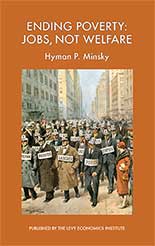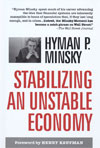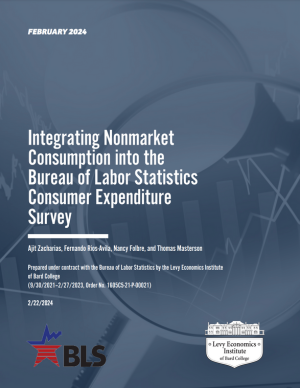
Publications
Hyman P. Minsky
-
Book Series | April 2013
By Hyman P. Minsky | Preface by Dimitri B. Papadimitriou | Introduction by L. Randall Wray
 Although Hyman P. Minsky is best known for his ideas about financial instability, he was equally concerned with the question of how to create a stable economy that puts an end to poverty for all who are willing and able to work. This collection of Minsky’s writing spans almost three decades of his published and previously unpublished work on the necessity of combating poverty through full employment policies—through job creation, not welfare.
Although Hyman P. Minsky is best known for his ideas about financial instability, he was equally concerned with the question of how to create a stable economy that puts an end to poverty for all who are willing and able to work. This collection of Minsky’s writing spans almost three decades of his published and previously unpublished work on the necessity of combating poverty through full employment policies—through job creation, not welfare.Minsky was an American economist who studied under Joseph Schumpeter and Wassily Leontief. He taught economics at Washington University, the University of California–Berkeley, Brown University, and Harvard University. Minsky joined the Levy Economics Institute of Bard College as a distinguished scholar in 1990, where he continued his research and writing until a few months before his death in October 1996. His two seminal books were Stabilizing an Unstable Economy and John Maynard Keynes, both of which were reissued by the Levy Institute in 2008.
Minsky held a B.S. in mathematics from the University of Chicago (1941) and an M.P.A. (1947) and a Ph.D. in economics (1954) from Harvard. He was a recipient in 1996 of the Veblen-Commons Award, given by the Association for Evolutionary Economics in recognition of his exemplary standards of scholarship, teaching, public service, and research in the field of evolutionary institutional economics.
This book was made possible in part through the generous support of the Ford Foundation and Andrew Sheng of the Fung Global Institute.
Published By:Associated Program(s):Author(s):Related Topic(s): -
Policy Note 2008/2 | June 2008
“At the annual banking structure and competition conference of the Federal Reserve Bank of Chicago in May 1987, the buzzword heard in the corridors and used by many of the speakers was ‘that which can be securitized, will be securitized.’” So notes Hyman Minsky in a prescient memo on the nature, and the implications, of securitization, written 20 years before an explosion in the securitization of home mortgages helped create the current financial crisis. This memo, which served as the basis for a lecture in Minsky’s monetary theory class at Washington University, has not been widely circulated. It is published here in its entirety, with a preface and an afterword by Senior Scholar L. Randall Wray that places Minsky’s work in context.
Download:Associated Program:Author(s): -
Book Series | May 2008
Hyman P. Minsky. Introduction by Dimitri B. Papadimitriou and L. Randall Wray

The late American economist and Distinguished Scholar Hyman P. Minsky first wrote about the inherent instability of financial markets in the late 1950s, and accurately predicted a transformation of the economy that would not become apparent for nearly a generation. In 2007, interest in his work suddenly exploded as the financial press recognized the relevance of his analysis to the meltdown of the mortgage-backed securities market. Indeed, in this book, first published in 1986, Minsky examined a number of financial crises in detail, several of which involved similar financial instruments, such as commercial paper, municipal bonds, and real estate and investment trusts. More important, he explained why the economy tends to evolve in such a way that these crises become more likely.
Minsky insisted that there is an inherent and fundamental instability in our sort of economy that tends toward a speculative boom. Unlike other critical analyses of capitalist processes, which emphasize the crash, Minsky was more concerned with the behavior of agents during the euphoric periods. And unlike other analyses that blame "shocks," "irrational exuberance," or "foolish" policy, he argued that the processes that generate financial fragility are "natural," or endogenous to the system.
Stabilizing an Unstable Economy is Minsky's seminal work, and it has been reissued so that it may be broadly available to a new generation of economists, analysts, and investors. The book covers, among other topics, the effect of speculative finance on investment and asset prices; booms and busts as unavoidable results of high-risk lending practices; government's role in bolstering consumption during times of high unemployment; and the need to increase Federal Reserve oversight of banks.
Published By:McGraw-HillAssociated Program:Author(s): -
Book Series | May 2008
Hyman P. Minsky. Introduction by Dimitri B. Papadimitriou and L. Randall Wray

This reissue of Hyman P. Minsky's classic book offers a timely reconsideration of the work of economics icon John Maynard Keynes. In it, Minsky argues that what most economists consider Keynesian economics is at odds with the major points of Keynes's The General Theory of Employment, Interest, and Money. Both Keynes and Minsky refuse to ignore pervasive uncertainty. Once uncertainty is given center stage, they observe, recurring financial crises are all but inescapable. For Minsky, economic calm on Main Street engenders financial system fragility that, in turn, ensures a perpetuation of boom-and-bust cycles.
As President Dimitri B. Papadimitriou and Senior Scholar L. Randall Wray write in their Introduction, this new edition of John Maynard Keynes has been published "in the hope that it will contribute to the reformation of economic theory so that it can address the world in which we actually live—the world that was always the topic of Minsky's analysis."
Hyman P. Minsky was an American economist who studied under Joseph Schumpeter and Wassily Leontief. He later taught economics at The University of California–Berkeley and at Washington, Brown, and Harvard Universities. In 1990, Minsky joined The Levy Economics Institute as a distinguished scholar, where he continued his research and writing until a few months before his death in October 1996.
Published By:McGraw-HillAssociated Program:Author(s): -
Book Series | August 2004
Edited and with an introduction by Dimitri B. Papadimitriou
 This unique volume presents, for the first time in publication, the original doctoral thesis of Hyman P. Minsky, one of the most innovative thinkers on financial markets. Dimitri B. Papadimitriou’s introduction places the thesis in a modern context, and explains its relevance today. The thesis explores the relationship between induced investment, the constraints of financing investment, market structure, and the determinants of aggregate demand and business cycle performance. Forming the basis of his subsequent development of financial Keynesianism and his “Wall Street” paradigm, Minsky investigates the relevance of the accelerator-multiplier models of investment to individual firm behavior in undertaking investment dependent on cost structure. Uncertainty, the coexistence of other market structures, and the behavior of the monetary system are also explored.
This unique volume presents, for the first time in publication, the original doctoral thesis of Hyman P. Minsky, one of the most innovative thinkers on financial markets. Dimitri B. Papadimitriou’s introduction places the thesis in a modern context, and explains its relevance today. The thesis explores the relationship between induced investment, the constraints of financing investment, market structure, and the determinants of aggregate demand and business cycle performance. Forming the basis of his subsequent development of financial Keynesianism and his “Wall Street” paradigm, Minsky investigates the relevance of the accelerator-multiplier models of investment to individual firm behavior in undertaking investment dependent on cost structure. Uncertainty, the coexistence of other market structures, and the behavior of the monetary system are also explored.
In assessing the assumptions underlying the structure and coefficient values of the accelerator models frequently used, the book addresses their limitations and inapplicability to real-world situations where the effect of financing conditions on the balance sheet structures of individual firms plays a crucial and determining role for further investment. Finally, Minsky discusses his findings on business cycle theory and economic policy.
This book will greatly appeal to advanced undergraduate and graduate students in economics, as well as to policymakers and researchers. In addition, it will prove to be valuable supplementary reading for those with an interest in advanced microeconomics.
Published By:Associated Program(s):Author(s): -
Working Paper No. 165 | May 1996
Economic Insecurity and the Institutional Prerequisites for Successful Capitalism
View More View LessIn this working paper, Distinguished Scholar Hyman P. Minsky and Visiting Scholar Charles Whalen search for reasons to account for the split in post-World War II economic performance—that is, the difference in performance between the 1946–66 period and the 1966–96 period. The authors discuss a number of economic problems that have arisen during the past quarter of a century, including slower growth, stagnant earnings, rising financial instability, and increasing inequality. Minksy and Whalen concede that factors such as globalization and technological change have undoubtedly played a role in the split performance. An additional important and often overlooked element is the evolution of the US financial structure. The authors explain that a key component influencing the evolution of the financial sector during recent decades has been the rise of "money manager" capitalism. Important features of money manager capitalism are increased financial fragility (lower margins of safety in indebtedness and a greater reliance on debt relative to internal finance) and the introduction into the financial structure of a new layer of intermediation. In particular, managers of pensions, trusts, and mutual funds currently control the largest share of the liabilities of corporations. These managers are judged by only one criterion: how well they maximize the value of funds. As a result, business leaders have become increasingly sensitive to the stock market valuation of their firm.
-
Working Paper No. 155 | April 1996
In this new working paper, Distinguished Scholar Hyman P. Minsky points out that capitalism in the United States is an evolving construct that recently entered a new stage: "money manager" capitalism. In money manager capitalism, nearly all businesses are organized as corporations, pension and mutual funds are the predominant owners of financial assets, and managers of these funds are judged solely on the total return on fund assets (dividends and interest plus appreciation in share value). One consequence of such a structure is the predominance of short-run considerations in decision making.
Public tolerance for uncertainty is limited. During the New Deal era it led to the creation of institutions and arrangements to create transparency in both financial markets and corporate governance; for example, crop insurance set floors to farmers' incomes and deficits run by the federal government set floors to aggregate profit flows. However, the focus of money manager capitalism on short-run returns and uncompromised profit margins has increased economic uncertainty at the firm and plant levels through the chronic need to downsize overhead and reduce variable costs. These activities have unraveled the traditional relationships between firm and worker and increased economic insecurity among employees.
Minsky asserts that existing institutions and programs cannot contain this uncertainty, and that new arrangements must be created to offset the effects on "losers" in the structure of money manager capitalism. He suggests that full-employment programs analogous to certain New Deal programs (e.g., the Work Progress Administration and the Civilian Conservation Corps) should be considered to meet this goal.
Download:Associated Program:Author(s): -
Working Paper No. 127 | October 1994
Public Policy Implications
No further information available.
Download:Associated Program:Author(s): -
Working Paper No. 126 | October 1994
Financial Institutions, Economic Policy, and the Dynamic Behavior of the Economy
View More View LessNo further information available.
Download:Associated Program:Author(s): -
Working Paper No. 93 | May 1993
The Limits of Capitalism
Once again the United States economy is facing a crisis, resolution of which first requires the realization that there are many types of capitalism: Solutions implemented in the past, therefore, may or may not be an appropriate solution today, as they could have been implemented as an answer to a problem posed within the context of a different model. Alternatively, the solution may lie in the implementation of a totally new economic regime in answer to reoccurring problems inherent in capitalism in general.
The implementation of a new model is not a unique happening in United States economic history. The interventionist model—set in motion by President Roosevelt in answer to the failure of the laissez-faire model in the 1930s—dealt with the obvious flaw inherent in capitalism in general namely, its inability to maintain a level of aggregate demand consistent with full employment. Implementation of the interventionist model prevented a massive depression of the type experienced in the 1930s from being repeated due to the larger role played by the government sector in maintaining demand via active fiscal policy, while moderating inflation through the use of monetary policy. The interventionist model also recognized the less obvious, deeper flaw of capitalism-namely, the manner in which the financial system can adversely affect the price of assets relative to that of current output. Absent any interventionist policy, the resulting decline in private investment and profits leads to a downward spiral and collapse of the financial sector.
The institutional roadblocks included in the interventionist model were sufficient to avert large disequilibriums in asset and output prices, thereby sustaining profits and precluding a deep recession. (Indeed, the Federal Reserve was not forced to act to avert a financial crisis until 1968, when problems arose in the commercial paper market.) The interventionist model, however, was abrogated during the 1980s with the reinstitution of a new laissez-faire model. The new model eliminated many of the restrictions imposed on financial sector, massive increases in national deficits through unproductive public sector spending (made even more inefficient by the resulting interest on the debt), and the growth of speculative financing schemes that left us with too many highly indebted firms. A large, financially induced depression was contained only through the reintroduction of massive governing monetary and fiscal intervention in the form of the S&L bailout and the maintenance of profits with massive deficits. Although the subsequent drop in interest rates has resulted in a rise in asset values and somewhat abated the turmoil in the financial markets, the economy continues to stagnate.
Download:Associated Program:Author(s): -
Public Policy Brief No. 3 | January 1993
A Proposal to Establish a Nationwide System of Community Development Banks
This brief proposes that the establishment of a nationwide system of community development banks (CDBs) would advance the capital development of the economy. The proposal is based on the notion that a critical function of the financial system is not being adequately performed by existing institutions for low-income citizens, inner-city minorities, and entrepreneurs who seek modest financing for small businesses. The primary goals of the CDBs are to deliver credit, payment, and savings opportunities to communities not well served by banks, and to provide financing throughout a designated area for businesses too small to attract the interest of the investment banking and normal commercial banking communities.
Download:Associated Program:Author(s): -
Working Paper No. 83 | December 1992
The Clinton/Gore proposal for the creation of a network of 100 community development banks (CDBs) to revitalize communities is bold, and will contribute to the success of the U.S. economy. Banks are essential institutions in any community, and the establishment of a bank is often a prerequisite for the investment process. For this reason, the creation of banks in communities lacking such institutions is important to the welfare of these communities.
The vitality of the American economy depends on the continual creation of new and initially small firms. Because it is in the public interest to foster the creation of new entrants into industry, trade, and finance, it is also in the public interest to have a set of strong, independent, profit-seeking banking institutions that specialize in financing smaller businesses.
When market forces fail to provide a service that is needed and potentially profitable, it is appropriate for government to help create the market. Community development banks fall into such a category. They do not require a government subsidy, and after start-up costs, the banks are expected to be profitable.
The primary perspective of this concept paper is that the main function of the financial structure is to advance the capital development of the economy-to increase the real productive capacity and wealth-producing ability of the economy. The second assumption is that capital development is encouraged by the provision of a broad range of financial services to various segments of the U.S. economy, including consumers, small and large businesses, retailers, developers, and all levels of government. The third is that the existing financial structure is particularly weak in servicing small and start-up businesses, and in servicing certain consumer groups. The fourth is that this problem has become more acute because of a decrease in the number of independent financing alternatives and a rise in the size distribution of financing sources, which have increased the financial system's bias toward larger transactions. These are assumptions that appear to be supported by the evidence: they are also incorporated in other proposals that advance programs to develop community development banking.
Download:Associated Program:Author(s): -
Working Paper No. 74 | May 1992
The Financial Instability Hypothesis (FIH) has both empirical and theoretical aspects that challenge the classic precepts of Smith and Walras, who implied that the economy can be best understood by assuming that it is constantly an equilibrium-seeking and sustaining system. The theoretical argument of the FIH emerges from the characterization of the economy as a capitalist economy with extensive capital assets and a sophisticated financial system.
In spite of the complexity of financial relations, the key determinant of system behavior remains the level of profits: the FIH incorporates a view in which aggregate demand determines profits. Hence, aggregate profits equal aggregate investment plus the government deficit. The FIH, therefore, considers the impact of debt on system behavior and also includes the manner in which debt is validated.
Minsky identifies hedge, speculative, and Ponzi finance as distinct income-debt relations for economic units. He asserts that if hedge financing dominates, then the economy may well be an equilibrium-seeking and containing system: conversely, the greater the weight of speculative and Ponzi finance, the greater the likelihood that the economy is a "deviation-amplifying" system. Thus, the FIH suggests that over periods of prolonged prosperity, capitalist economies tend to move from a financial structure dominated by hedge finance (stable) to a structure that increasingly emphasizes speculative and Ponzi finance (unstable). The FIH is a model of a capitalist economy that does not rely on exogenous shocks to generate business cycles of varying severity: business cycles of history are compounded out of (i) the internal dynamics of capitalist economies, and (ii) the system of interventions and regulations that are designed to keep the economy operating within reasonable bounds.
Download:Associated Program:Author(s): -
Working Paper No. 72 | January 1992
The Capital Development of the Economy and the Structure of Financial Institutions
View More View LessThis paper evolves from the sharp contrast in Smithian and Keynesian views about the relationship between the financial structure and the economy. The Smithian perspective implies that the financial structure is irrelevant, whereas the Keynesian position concludes that effective financing is necessary for the "capital development of the economy"- there is also a need to constrain any tendency of what Keynes referred to as speculation to dominate. Thus, the essential elements of equilibrium in Keynesian theory, the financial theory of investment and the investment theory of business cycles, are most apt when examined as outcomes of processes that operate over time.
During the 1980s, there was a sharp increase in speculative financing resulting from the trend toward leveraged buyouts and the rising demand for short-term marketable corporate liabilities. A main characteristic of a capitalist economy that is stagnant or immersed in a depression is that the capital development of the economy is not progressing. The 1980s were filled with examples of financing inept investments, while the current climate is one of grossly inadequate investment levels to create a progressive full-employment economy.
The financial instability interpretation of Keynes rests upon the profitability of debt financing, and incorporates the potential collapse of asset values in an environment of speculative and Ponzi financing. Consequently, the financial structure is significantly more fragile today than earlier in the post World War II era.
Download:Associated Program:Author(s): -
Working Paper No. 69 | January 1992
Some Fundamental Issues
Deposit insurance, the savings and loan industry, facets of the insurance industry, and a significant number of private banks have all been plagued by recent collapse. The legislative agenda goes beyond merely funding the shortfall in deposit insurance funds: Congress has suggested that reforming the deposit insurance function, as well as the associated regulatory and supervisory structure, is imperative to avoid a recurrence of Treasury financing.
An assessment of the problem, and also the prescriptions for a cure, rely on the particular theoretical perspective of the observer. The Smithian view asserts that markets always lead to the promotion of public welfare, while Keynesian theory states that market processes may lead to malfunction of the capital development of the economy-that is, something other than the promotion of public welfare. For example, the crisis in finance during 1991 is largely a delayed response to the experiment in practical monetarism that occurred from 1979 to 1982. In typically simplistic fashion, monetarism suggests that inflation is always the result of too much money chasing too few goods: Hence, controlling inflation rests on controlling money supply.
The fundamental flaw in the Bush administration's proposals is that they subscribe to a Smithian theme. They impute the problems afflicting the finance industry (e.g. lack of capital development of the economy) to a minor flaw in the institutional structure rather than to basic characteristics of the economy. The recommendations submitted in the paper are inherently distinct from the administration's proposal and have evolved from a Keynesian model of the economy specifying the processes and determinants of the performance of the economy.
Download:Associated Program:Author(s): -
Working Paper No. 66 | November 1991
Financial Options
The social transformation of Eastern Europe has proceeded much faster, and the destruction of communism's legitimacy and efficacy has been more complete, than was deemed possible even a few years ago. A common tenet among the economies now emerging from communism is the lack of significant private wealth, even though there are capital assets that are used in production and have the potential to generate profits. However, since there is no relevant history of profits in the emerging economies, there is no way to meaningfully assess values of capital assets.
The financial system provides for linkages through time: Exchanges of money for well-defined claims to future-money flow are made daily. Thus, the financial structure and the physical capital assets of a capitalist economy link the present and the past to the future.
The options available to the emerging economies with respect to their financial structure are limited-the lack of significant private wealth leads to weak market for financial instruments and poor prospects for market-based financing. The initial choice of a financial structure is constrained to universal banks or public holding companies. Special venture capital holding companies and local independent banks should be integrated into the financial structure to facilitate entrepreneurial spirit. The public holding company is favored as a transitional instrument to foster the development of information and private wealth, and should be modeled after the Reconstruction Finance Corporation of the New Deal era.
Download:Associated Program:Author(s): -
Working Paper No. 64 | November 1991
This paper suggests that there are two longstanding views on business cycles and economic dynamics: One emphasizes endogenous stability plus exogenous disturbances, while the other focuses on endogenous instability plus institutional 'containing' or "thwarting" mechanisms. The latter tradition regards business cycles and economic instability as the natural and inherent consequence of self-interest-motivated behavior in complex economies with sophisticated financial institutions. In fact, it is the interaction between the system's endoge-nous dynamics and the effects of institutions and interventions which, if "apt," constrains the outcomes of capitalist market processes to acceptable outcomes.
The endogenous instability view of the economy, in which institutional structures and interventions stabilize the fragile, essentially refutes Lucas: He asserts that the economy is a mechanism that transforms exogenous shocks (either random or unanticipated policy interventions) into business cycles, thus generating a growth equilibrium. Recent history has illustrated the flaws of laissez-faire theory as the postwar capitalist economies that have enjoyed consistently high levels of growth are big government interventionist economies. The challenge for the future is recognizing that market processes are deficient not only in their ability to maintain aggregate demand, but also as devices for assuring productive investment and a tolerable distribution of income.
-
Working Paper No. 51 | April 1991
Systemic or Idiosyncratic
The presentations at this conference are by economists from Academies and economists who professionally confront real world problems, either in private finance or in public policy. As economists we accept that the remarks made by Keynes in the closing passage of The General Theory are true: "... the ideas of economists and political philosophers, both when they are right and when they are wrong, are more powerful than is commonly understood. Indeed the world is ruled by little else. Practical men, who believe themselves to be quite exempt from any intellectual influences, are usually the slaves of some defunct economist. ....I am sure the power of vested interests is vastly exaggerated compared with the gradual encroachment of ideas. ... Soon or late it is ideas, not vested interests, which are dangerous for good or evil."
We like this assertion not only because it makes us important but also because it makes good sense.
The ideas that Keynes refers to are theories. A theory prior for rational action. A of system behavior is a proposed action, whether by individual agents in households or firms, a bank, a government agency or a legislative body is appropriate action only as a theory connects the action to the desired result. Because some institutions, such as deposit insurance, the savings and loan industry, and a number of the great private banks, that served the economy well during the first two generations after the great depression, seem to have broken down, the need to reform and to reconstitute the financial structure is now on the legislative agenda.
As we try to fix the financial system three questions should be asked of the pushers of a policy proposal:
- "What is it that is taken to be broke?",
- "What theory about proposal?"
- What are the dire consequences of not fixing that which you assert is broke?
In what follows I will take up three points
- Two views of the results of the economic process
- Systemic and idiosyncratic sources of financial crises
- Some ideas about the scope for policy in the present "crisis".
Download:Associated Program:Author(s):

